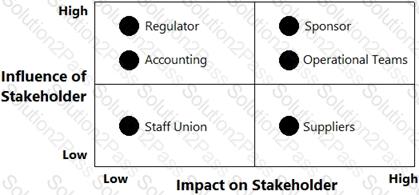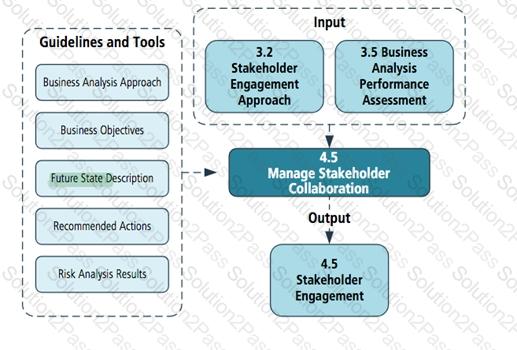CCBA IIBA Certification of Capability in Business Analysis (CCBA) Free Practice Exam Questions (2025 Updated)
Prepare effectively for your IIBA CCBA Certification of Capability in Business Analysis (CCBA) certification with our extensive collection of free, high-quality practice questions. Each question is designed to mirror the actual exam format and objectives, complete with comprehensive answers and detailed explanations. Our materials are regularly updated for 2025, ensuring you have the most current resources to build confidence and succeed on your first attempt.
A business analyst (BA) has just started a large project and is collaborating with stakeholders to define requirements. Another BA is joining soon to help with this initiative. What action should the BA take to ensure that the new BA understands the project?
A business analyst (BA) has executed the last planned workshop in a series in order to verify requirements. All issues have been logged in an issues register. What technique is used to manage and resolve the outstanding issues?
A business analyst (BA) is examining the relationships between elicited requirements on a project. What quality criteria must be satisfied when the BA is defining requirements relationships?
A business analyst (BA) has completed multiple workshops involving a number of stakeholders, including the project manager; however, the elicitation results are inconsistent between the stakeholders. How should the variation in results be resolved?
A business analyst (BA) has elicited non-functional information for a system's replacement. In reviewing the elicitation results, the BA finds the number of concurrent users is a large portion of the target user group, which seems high. How should the BA proceed?
A newly implemented personal loan financing system has been in operation for one month. The business objective is to reduce the loan processing time from 11 days to 3 days, but it is currently occurring in 4.5 days. What must the business analyst (BA) do next?
A business analyst (BA) is supporting an organization in its product launch. The BA wants to identify assumptions about the benefits resulting from the new product. What does identifying assumptions help the BA manage?
A business analyst (BA) is tasked with performing a gap analysis between two existing systems to combine into a single system or run just one system. Which of the following modeling formats will show the requirements for both systems side by side?
The director of a furniture store manages a group of skilled carpenters who make furniture from locally available materials. The director decides to automate its inventory processes so that the carpenters can place orders for raw materials themselves. A business analyst (BA) is engaged to define the requirements and propose options for commercial off-the-shelf (COTS) inventory management solutions. After meeting with the director, the BA needs to schedule a workshop with the carpenters to:
A business analyst (BA) is working on a project to provide a temporary solution that will last for two months. The BA is feeling overwhelmed with the work needed to create the huge number of links to provide full traceability from solution requirements to design for this solution. How can the BA justify omitting all possible links?
During the analysis, synthesis, and refinement of elicitation results the business analyst (BA) has discovered that some information is missing. Which course of action would resolve the situation?
Stakeholders need a financial report that can be published and distributed to multiple end users. They would also like the report to be developed within a specific time frame and within cost. What must the business analyst (BA) do to achieve this goal?
A business analyst (BA) is conducting a workshop with the purpose of analyzing a business process. Stakeholders of different business units are in attendance. Each stakeholder is able to explain their unit's contribution to the process, however, there is no end to end process owner who can provide a consolidated view. Which technique should the BA use to compare the stakeholder's inputs against each other in order to check for consistency and omissions?
A business analyst (BA) identified that a stakeholder requirement for an online system led to a functional requirement to provide a user login screen. This is an example of which type of traceability relationship?
The business analyst (BA) has prepared a requirements package and it is now ready to present to the stakeholders. What is the purpose of presenting the package?
A business analyst (BA) is working on a complex project involving many stakeholders for which the business case has been previously completed and signed off. After an organizational restructure, new stakeholders have been assigned to the project working group, but do not see the value in the project outcomes and refuse to collaborate. What is a guideline or tool the BA can use to focus stakeholders on a common goal?
One of the tasks that the business analyst (BA) needs to complete is to maintain the requirements. As much as the BA values and sees the benefits of maintaining the requirements, the project manager (PM) does not see the same. In order to help the PM understand the value of this task, which following benefit of maintaining the requirements should the BA communicate to the PM?
A business analyst (BA) is identifying the functions and features required for a new enterprise software solution. The BA reviews historical documents about the current business processes and then interviews each stakeholder group, individually, asking Questions about current business processes. The BA compares the information obtained during the stakeholder interviews with the information gathered from the historical documents. Which activity is the BA performing with this approach?
A business analyst (BA) must model information characteristics across multiple information systems for a project. What type of model captures this information?
A certain stakeholder requirement has been analyzed and broken down into several solution requirements, each affecting a different IT system. After solution design, the business analyst (BA) receives feedback that
one of the IT systems will take longer than anticipated to implement. What requirements artifact or technique will assist the BA in better understanding the related requirements?
A one-location restaurant has been a huge success and the owner wants to expand into more markets. The owner wants to ensure that the quality of the food and pleasing atmosphere is maintained without introducing new variables. Working with the key members of the organization, the owner determines that training and standard processes must be defined. The owner engages a business analyst (BA) to create training materials and operating procedures based on the existing processes at the original restaurant. During this documentation, the BA identifies some opportunities for improvement. How must the BA proceed?
A business analyst (BA) is measuring solution performance of a new system. What should the BA consider to avoid skewed results and an inaccurate conclusion?
A business analyst (BA) is working on a project that follows incremental and iterative approaches. The BA and the stakeholders have shortlisted several user stories to be considered in the project scope. Which of the following methods would enable them to arrive at a common understanding on delivering value in the product and ranking the stories?
Requirements have been prioritized in the product backlog for inclusion in the upcoming release. One of the project team members fears that at least one requirement from the prioritization list is not finalized and still requires further analysis. Which of the following factors describe the affected requirement?
A large online retailer is introducing new technology to upgrade its aging ordering process. The business analyst (BA) has drawn a stakeholder matrix showing information on how to engage with the stakeholders throughout the project.

Using the stakeholder matrix as a guide, how should the BA engage the suppliers?
A passport agency has recently deployed an online system where customers can apply for, amend, and renew passports. The expected volumes have not been realized and as a result, the agency has not achieved the projected savings. A business analyst (BA) has been asked to investigate the potential causes of this shortfall by understanding the trends, patterns. and volumes at a detailed level. What method of requirements elicitation should the BA start with?
A business analyst (BA) is determining the current state as part of a new project. What is an internal enterprise asset that the BA must include in the analysis?
A business analyst (BA) is eliciting requirements for a pharmaceutical distribution company with an expansion plan across many states, each with their own tools and methods. To make the requirements as re-usable as possible, what should the BA do?
A senior business analyst (BA) is tasked with verifying a set of requirements written by a junior BA for a
system. During this exercise, the junior BA will ensure that the requirements exhibit atomic characteristics. The senior BA will be verifying that the requirements:
A business analyst (BA) identifies a design option that enhances the performance of the business by automating repetitive tasks that require multiple staff touchpoints to complete a single task. Which type of improvement opportunity is identified by the BA?
 Diagram
Description automatically generated
Diagram
Description automatically generated